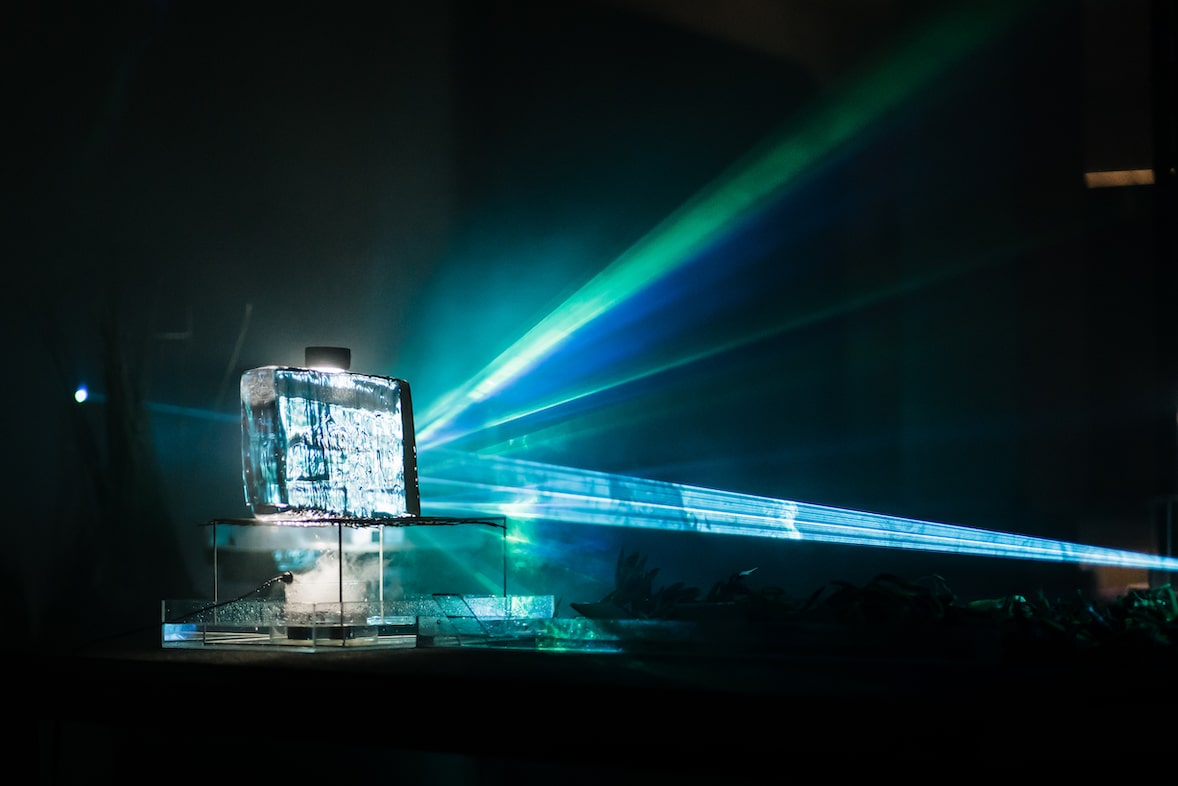
 © Lais Pereira / Sonar+D
© Lais Pereira / Sonar+DFrom Order to Disorder and Back – featuring ICARUS Performance
An evening on Phasetransitions in Matter, Mind and Society
this is the night for everyone who loves to cross borders and open the mind.
Enjoy sharp-witted debates about Arts, Natural Sciences and Political Systems between provocative thinkers in their field
A night you will not forget – let’s talk!
————————————————————-
6pm doors open, exhibitions, micro-labs
7pm stage
8:30pm The Icarus Performance
————————————————————-
Stage
From Order to Disorder and Back
an introduction by Francisca Rocha Gonçalves and Carsten Hucho
Pitches:
From chaos to order: How large collectives benefit from being in a critical state between complete disorder and strong structure (David Bierbach, Leibniz-Institut für Gewässerökologie und Binnenfischerei, Excellence-Cluster „Science of Intelligence” (HU Berlin / IGB))
Flashing fireflies and clapping against the beat – how large crowds synch (Manisha Biswas, Humboldt-Universtität zu Berlin)
A world under stress – from order to disorder (Stefan Kroll, Peace Research Institute, Frankfurt)
Permanently on the brink of disorder – On the enduring imminence of the AI revolution (Rainer Rehak, Weizenbaum Institute for the Networked Society)
Debate
What are you talking about?!
How science influences what we see – how what we see influences science
Martin Eder – contemporary artist
Stefan Kroll – Peace Research Institute, Frankfurt
David Bierbach – Humboldt Universtität zu Berlin (HUB) und Leibniz-Institut für Gewässerökologie und Binnenfischerei (IGB)
Manisha Biswas – Humboldt Universität zu Berlin
Rainer Rehak – Weizenbaum Institute for the Networked Society
Johannes Goessling – CESAM, University of Aveiro
moderated by Carsten Hucho (PDI)
8:30pm
Johannes Goessling: Diatoms
The Icarus Performance
by Francisca Rocha Gonçalves , James Diamond , Johannes Gössling
Discover the enchanting fusion of art and science in ICARUS: Diatom Ice Structures. This innovative performance bridges the gap between art and science, channelling inspiration from the delicate glass shells of diatom algae and transforming them into meter-sized ice sculptures. Experience the masterful ice carving of James Diamond, complemented by the immersive sound and laser projections by Francisca Rocha Goncalves.
Meet the artists and the scientists at the bar for a deep-dive – all night until lights get too bright
Exhibitions and Demonstrations
Leibniz-Forschungsinstitut für Molekulare Pharmakologie & ChemLab
Magische blaue Flasche
Wir lassen eine scheinbar gewöhnliche blaue Flüssigkeit vor Ihren Augen verschwinden! Mit einem einfachen Schütteln verwandelt sich die blaue Farbe in kristallklares Wasser. Doch wie durch Zauberhand kehrt das Blau zurück, als wäre nichts geschehen. Dieses Wunderwerk der Chemie basiert auf einer Redox-Reaktion, bei der Methylenblau durch die Zugabe von Glucose in sein farbloses Gegenstück verwandelt wird. Ein wenig Sauerstoff dazu und das Blau erstrahlt wieder.
Die zauberhafte Chemie-Ampel
Die “Chemischen Ampel”: Hier wandelt sich die blaue Pracht des Indigocarmins in ein strahlendes Gelb, das sich mit Blau mischt und so ein leuchtendes Grün kreiert. Ein Schütteln reicht aus, um die Lösung über eine faszinierende rote Zwischenstufe wieder in das ursprüngliche Blau zu verwandeln.
Das geheimnisvolle Trockeneis
Beobachten Sie, wie sich festes CO2 direkt in Nebel verwandelt, ohne zu schmelzen – ein Prozess, bekannt als Sublimation.
Leibniz-Institut für Kristallzüchtung
From Hot & Cold Crystals – Why order matters
let’s experience phase transitions in experiments and clarify the following questions: How do hand warmer pads work?
How can you build your own fog machine?
What shouldn’t you do at -50°C at the South Pole if you want to stay alive?
Leibniz-Institut für Gewässerökologie und Binnenfischerei
The Robo Fish: smart shoals
Inspired by the rules that shape fish and bird swarms, the project that underlies this demonstrator explores the complexities of social interactions. The robotic fish integrates itself into groups of live fish and enable thus the study of social processes within groups – something that is not possible without Robo Fish! In this demonstrator, you can steer the Robo Fish and test how well you would act as a “real” fish. The Robo Fish holds immense research potential, fostering collaborations with biologists, roboticists and physicists. Explore collective behaviour and its connection to robotics and artificial intelligence!
Max-Born-Institut für Nichtlineare Optik und Kurzzeitspektroskopie
How can we observe ultrafast phase transitions? We will demonstrate how the stroboscope-effect makes the unveblievably fast appear almost static
PUBLIC TALK AND PERFORMANCE AT THE FORUM.
This is an in-person event. Attending the event is free of charge and requires no registration. The event takes place in both English and German.
This event will take place as part of the Berlin Science Week Art & Science FORUM at Holzmarkt and will be held in the Säälchen. The location is wheelchair accessible.
Carsten Hucho
Paul-Drude-Institut für Festkörperelektronik (PDI)
Francisca Rocha Goncalves
INSTITUT FÜR GEWÄSSERÖKOLOGIE UND BINNENFISCHEREI
James Diamond
Berlin
Johannes W. Gössling
Berlin
Manisha Biswas
Berlin School of Mind and Brain, Humboldt University
David Bierbach
Excellence-Cluster "Science of Intelligence"
Rainer Rehak
Weizenbaum-Institut
